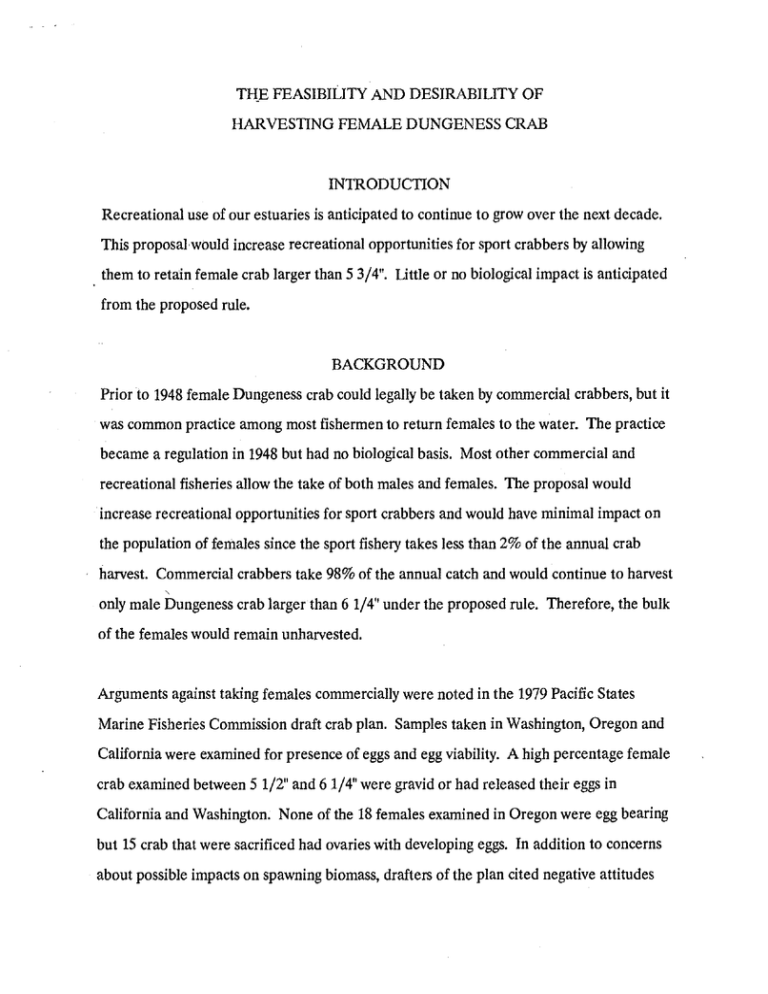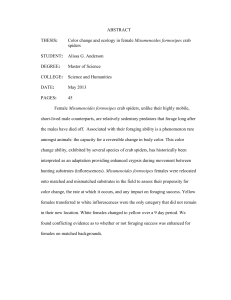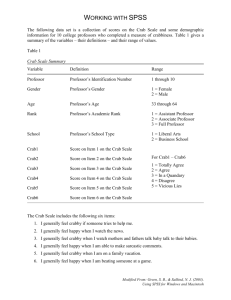THE FEASIBILITY AND DESIRABILITY OF HARVESTING FEMALE DUNGENESS CRAB INTRODUCTION
advertisement

TH.E
FEASIBUJTY AND DESIRABILITY OF
THE FEASIBILITY
HARVESTING FEMALE DUNGENESS CRAB
INTRODUCTION
of our estuaries
estuaries is
is anticipated to continue to
to grow over the next decade.
Recreational use
use of
Recreational
This proposal
proposaiwould
would increase
increase recreational
recreational opportunities
opportunitiesfor
for sport
sportcrabbers
crabbersby
byallowing
allowing
orno
no biological
biological impact is anticipated
them to retain female crab larger than 55 3/4". Little
Little or
from the proposed rule.
WK*XSI {11IRI*]
BACKGROUND
1948 female
Prior to 1948
female Dungeness crab could
could legally
legallybe
be taken
taken by
by commercial
commercial crabbers,
crabbers, but
but itit
was common
common practice
practice among
amongmost
mostfishermen
fishermentotoreturn
returnfemales
femalestotothe
thewater.
water. The
The practice
1948 but
became a regulation in 1948
but had
had no
no biological
biologicalbasis.
basis. Most
Most other
other commercial and
The proposal
proposal would
would
recreational fisheries
fisheries allow the take of both males and females.
recreational
females, The
opportunities for
for sport
sport crabbers
crabbers and
and would
would have minimal impact on
increase recreational opportunities
the population of females since
since the sport fishery
fishery takes
takes less
lessthan
than 2%
2% of
ofthe
the annual
annual crab
crab
harvest.
Commercial crabbers take 98%
98% of the annual catch and would
harvest. Commercial
would continue
continue to harvest
harvest
,
only
only male
male Dungeness
bungeness crab
crab larger
larger than
than 61/4"
6 1/4" under
under the
the proposed
proposed rule.
rule. Therefore, the bulk
remain unliarvested.
unharvested.
of the females would remain
Arguments against taking females commercially were noted in the 1979
1979 Pacific States
Marine Fisheries Commission
Commission draft
Samples taken in
in Washington, Oregon and
draft crab
crab plan.
plan. Samples
California were examined for presence of eggs
eggs and
and egg
egg viability.
viability. A
A high
high percentage
percentage female
female
crab examined between 55 1/2" and 661/4"
1/4" were gravid
gravid or
or had released their eggs
eggs in
of the
the 18
18 females examined in Oregon were egg bearing
Washington. None
None of
California and Washington.
15 crab that were sacrificed had ovaries with
but 15
with developing
developing eggs.
eggs. In addition to concerns
about possible impacts on spawning
spawning biomass,
biomass, drafters
drafters of
of the
the plan
plan cited
cited negative
negative attitudes
of plant
plant operators,
operators, crab
crab shakers
shakers and
and commercial
commercial fishermen
fishermen towards
towards harvesting
harvesting
on part of
Themeat
meatyield
yieldisislower
lower for
for female
female crab
crab averaging
averaging 15.9%
15.9% compared to
to 27.6%
27.6%
female crab. The
for males, and shakers maintain that they can't shake female
female crab fast
fast enough
enough to
to make
make
wages.
Some of the biological concerns can be addressed by
by an explanation
explanation of
of crab
crab mating
mating
behavior and success.
success. Many
Many years
years of
of observation
observation have
have shown
shown that
that the
the spawning
spawning cycle
cycle takes .
ocean although a few females
place in the ocean
females with
with eggs
eggshave
havebeen
beenseen
seenininestuaries.
estuaries. Female
Dungeness crabs produce 1 to 3 million
million eggs.
eggs. Mating
Mating takes
takes place
place between
between aa hard
hard male and
If the
the female
female does
does not
not shed
shed
a soft female immediately after the female sheds her old shell.
shell. If
A recent
recent study
study in California (Hanldn,
(Hankin, et al,
aI, 1983)
her old shell, mating does
does not take place.
place. A
1983)
has shown that the frequency of
of molting and survival rate of female crabs over 5 1/2"
1/2" in
in
The probability
probability therefore
therefore exists
exists that female crab larger
larger than
than 55 1/2"
width is
is about 10%. The
1/2"
to the
the spawning
spawning biomass.
if these females were all viable
contribute little to
biomass. Even if
viable and
and
eggs, the
producing eggs,
the impact of allowing
allowingthem
themto
to be
be harvested
harvested in
in the
the recreational fishery
of
would be nil due to the low numbers
numbers that would
would be
be taken
taken relative to the total population of
female crab.
While the commercial industry has remained in opposition to harvesting of female crab,
sport crabbers indicate a keen desire
desire to
to do
do so.
In 1988 and 1989
1989 test fishing
fishing was
was done
done in
in Alsea
Alsea Bay
Bay to
to determine
determine when the females were in
female/male ratio
ratio for
for crabs
crabs 55 3/4 inches
Table 11 summaries
the bay and the female/male
inches and larger.
larger. Table
the tests.
Overall about 22 females were caught for every male, but from July through
tests. Overall
September the ratio was 5 to
to 1.
1. A number of large females
females were
were cooked
cooked and
andpicked.
picked. Meat
yield ranged from 9-22
9-22 percent (Table 2) with texture and flavor similar
similar to
to male
male crabs.
crabs. In
the sport crab fishery
fishery most
most crabbers
crabbers are
are more
more interested
interested in
in the
the number
number of
of crab
ërab rather
rather than
quality
quality as
as about
about 30% of the crabs taken are soft.
During a 2-year sport crab survey
survey in
in Alsea
Alsea Bay
Bay(4)
(4)crabbers
crabbers frequently
frequently asked
asked about
about taking
taking
large females.
When informed
informedof
ofthe
thebiological
biological facts
facts nearly
nearly everyone favored taking
females. When
atseven
sevensport
sportangling
angling workshops in 1988
females.
Further, at
females. Further,
1988there
there was
wasbroad
broad support
support for
for
is clear
clear that
thatto
tosport
sportcrabbers
crabberstaking
taking females
females is
is highly desirable.
taking female crabs.
crabs. ItIt is
Using estimated catch figures from the Alsea Bay study
study (4)
(4) the
the sport
sport crab catch could
possible
1988. As it was
of the crabbers sampled in 1988-89
1988-89 (4)
possible have
have been
been tripled in 1988.
was 50%
50%of
(4)
If female crabs
crabs were taken more people
people would have their fishing
didn't catch anything.
anything. If
experience enhanced with
with no
no risk
risk to
to the
the resource.
resource. Recent regulation changes in California
loweredthe
thesize
sizelimit
limitOf
ofcrabs
crabs to
to 553/4
3/4inches
inches including
including females.
females.
lowred
RECOMMENDATION
Staff recommends
12 male sir
or female crab
recommends allowing
allowing recreational
recreational crabbers to retain up to 12
The recommended
recommended rule
rule provides
provides a significant enhancement
greater than 5 3/4"
3/4° per day. The
enhancement
the recreational
recreationalfishery
fishery having
having little
little or
orno
nobiological
biological risk.
risk.
opportunity for the
References
1.
David Hankin,
1983. Molt
Hankin, Nancy
Nancy Diamond,
Diamond,Michael
MichaelMahr
Mahrand
andJames
JamesIanelli.
lanelli. 1983.
increments, annual molting probabilities, fecundity and survival
survival rates
rates of adult
Dungeness crabs
HumboltState
StateUniv.,
Univ., Arcata,
Arcata, CA.
CA.
female Dungeness
crabs in
in northern
northern California.
California Humbolt
2.
W. Botsford
1990. Population
Population dynamics
dynamics of the
Louis W.
Botsford and
and Roderick C.
C. Hobbs.
Hobbs. 1990.
Dungeness crab (Cancer
(Cancer magister)
magister)II.
n. Wildlife and Fisheries Biology, Univ. of
California, Davis, CA.
3.
Dungeness crab
crab fishery
fishery off Washington, .
Draft fishery management plan for the Dungeness
Oregon and California. 1979.
1979. Pacific
Pacific Fishery
Fishery Management
Management Council,
Council, Portland,
Portland, OR.
OR.
4.
Darrell Demory. 1990.
1990. Alsea
AlseaBay
Baysport
sportcrab
crabsurvey,
survey, 1988-89.
1988-89. Staff report in
progress.
Oregon Department
Departmentof
ofFish
Fish and
and Wildlife.
Wildlife.
progress. Oregon
Table 1. Number
Number of
offemale
and male
male crabs
crabs 5 3/4
3/4 inches
inches in width or larger taken in Alsea
female and
Alsea
1988-89.
Bay by sample,
sample, 1988-89.
Sample
Sample Date
2-04-88
2-19-88
3-15-88
4-15-88
5-12-88
7-25-88
8-04-88
8-22-88
9-15-88
10-3-88
10-19-88
12-2-88
8-10-89
Females
Males
0
0
11
3
3
21
9
48
28
8
11
0
100
0
0
0
0
0
10
0
6
4
17
3
2
49
Ratio
0
0
1/0
3/0
3/0
2/1
9/0
8/1
7/1
1/2
1/3
0/2
2/1
Table 2.
Percent meat
meat yield
yield of
of female Dungeness crab
2. Percent
crab 55 3/4
3/4 inches
inches or
or larger from
from Alsea
Alsea
Bay, 1988-89.
.
Whole Wt. (gms)
539
568
454
483
568
483
625
625
562
513
618
.643
643
547
502
537
554
500
577
633
521
555
525
494
577
535
535
583
573
526
548
615
539
532
600
Meat Wt. (gms)
118
122
105
95
133
115
131
129
122
77
97
109
74
68
114
110
97
116
90
80
106
79
102
97
47
117
116
110
101
110
76
96
99
88
% Meat
18.9
14.8
23.1
19,7
19.7
23.4
23.8
21.0
20.6
21.7
15.0
15.7
17.0
13.5
13.5
21.2
19.9
19.4
20.1
14.2
15.4
19.1
15.0
20.6
16.8
8.8
21.9
19.9
19.2
19.2
20.1
12.4
17.8
18.6
14.7




